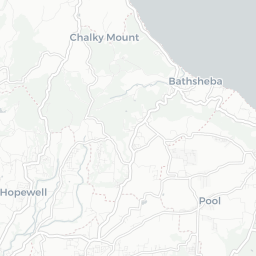






Associated People (4) |
|
The dates listed below have different categories as denoted by the letters in the brackets following each date. Here is a key to explain those letter codes:
|
|
- 1811 [LA] → Owner
|
|
1812 [EA] - 1816 [LA] → Owner
Bought by Thomas Daniel, who also had substantial mortgage on the estate. |
|
1817 [EA] - 1831 [LA] → Owner
|
|
1832 [EA] - 1832 [LA] → Executor
|
Associated Claims (1) |
|
£3,839 4S 4D
|
Notes |
|
From the 1670s, the Walter family – initially Richard Walter – acquired land which was to become the Apes Hill plantation. By 1697, a marriage settlement between John Walter, son of Richard Walter, and Lucy Alleyne, the daughter of Abel Alleyne. Richard Walter’s plantation called Apes Hill, 300 acres, 203 slaves In 1726 John Walter of Busbridge Park, Surrey, England, sold to his brother-in-law, the Hon. Alexander Walker of St. James, 2 plantations in St. James, St. Thomas & St. Andrew: (1) Apes Hill and (2) Evans (Water Hall). Total area 536 acres, £25,000, 2 mansion houses, 2 sugar mills, 139 enslaved at Apes Hill (95 at Water Hall). The 1729 will of the Hon. Alexander Walker stated that the Evans plantation was 209 acres. Therefore Apes Hill probably 327 acres. Apes Hill was bequeathed to his son William Walker. At some point and in an unknown way, Apes Hill beame the property of Abel Walter, from whom it passed to his son John Walter. |
Sources |
|
Barbados Department of Archives. Hughes-Queree Index of Plantations. |
Estate Information (10) |
|
1812
Since the C17th, Apes Hill had been owned by the Walter family. In 1812, by his Will, John Walter of South Baddesley, Hampshire, England, ordered the sale of Apes Hill and Mount Wilton. Both were bought by Thomas Daniel, who had large mortgages on both.
Barbados Department of Archives. Hughes-Queree Index of Plantations.
|
|
1816
[Number of enslaved people] 134(Tot)
[Size] 401 Thomas Daniel sold Apes Hill to John William Perch of St. James: 401 acres, mansion house and sugar works for £26,000 of which Daniel took mortgage for £18,000.
Barbados Department of Archives. Hughes-Queree Index of Plantations.
|
|
1816
[Size] 401
In 1816 Thomas Daniel sold Apes Hill plantation to John William Perch of St. James. 401 acres, mansion house and sugar works for £26,000 of which Daniel took mortgage for £18,000.
Barbados Department of Archives. Hughes-Queree Index of Plantations.
|
|
1817
[Number of enslaved people] 168(Tot) 92(F) 76(M)
Return of John William Perch, his own property.
T71/522 70-74
|
|
1822
[Number of enslaved people] 147(Tot)
[Name] [No name given] [Size] 246 In a Levy Book for St James, Barbados, 1822, Perch was listed as owning 147 enslaved and 246 acres of land.
Barbados Department of Archives, RB9/3/7. Levy Book for St James, 1822.
|
|
1823
[Number of enslaved people] 164(Tot)
[Name] [No name given] Return of John William Perch, his own property. Previously 161 enslaved.
T71/531 294-6
|
|
1826
[Number of enslaved people] 169(Tot)
[Name] [No name given] Return of John William Perch, his own property. Previously 164 enslaved.
T71/538 174-6
|
|
1829
[Number of enslaved people] 180(Tot)
[Name] Apes Hill Return of John W. Perch, his own property.
T71/542 183-4
|
|
1832
[Number of enslaved people] 166(Tot)
Return of George Hewitt, Executor, the property of the estate of John W. Perch, deceased. [It was subsequently owned, by the 1840s and until the 1860s, by George Perch.]
T71/551 173-4
|
|
1913
[Name] Apes Hill
[Size] 453 Listed in St James, property of Austin.
Barbados 1913 list from the Hughes-Quere indexes transcribed at https://creolelinks.com/1913-barbados-plantation-owners-names.html.
|